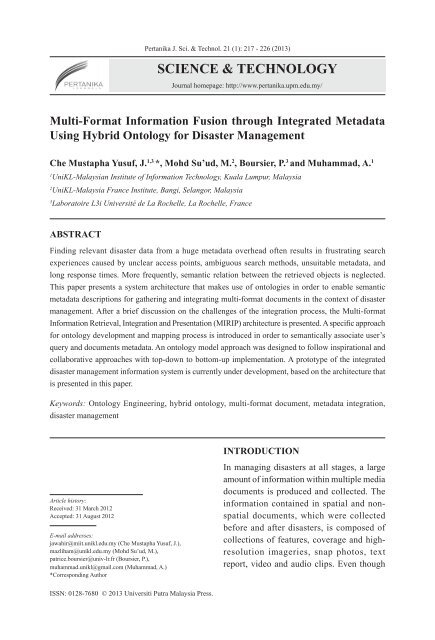JST Vol. 21 (1) Jan. 2013 - Pertanika Journal - Universiti Putra ...
JST Vol. 21 (1) Jan. 2013 - Pertanika Journal - Universiti Putra ...
JST Vol. 21 (1) Jan. 2013 - Pertanika Journal - Universiti Putra ...
Create successful ePaper yourself
Turn your PDF publications into a flip-book with our unique Google optimized e-Paper software.
ISSN: 0128-7680 © <strong>2013</strong> <strong>Universiti</strong> <strong>Putra</strong> Malaysia Press.<br />
<strong>Pertanika</strong> J. Sci. & Technol. <strong>21</strong> (1): <strong>21</strong>7 - 226 (<strong>2013</strong>)<br />
SCIENCE & TECHNOLOGY<br />
<strong>Journal</strong> homepage: http://www.pertanika.upm.edu.my/<br />
Multi-Format Information Fusion through Integrated Metadata<br />
Using Hybrid Ontology for Disaster Management<br />
Che Mustapha Yusuf, J. 1,3 *, Mohd Su’ud, M. 2 , Boursier, P. 3 and Muhammad, A. 1<br />
1 UniKL-Malaysian Institute of Information Technology, Kuala Lumpur, Malaysia<br />
2 UniKL-Malaysia France Institute, Bangi, Selangor, Malaysia<br />
3 Laboratoire L3i Université de La Rochelle, La Rochelle, France<br />
ABSTRACT<br />
Finding relevant disaster data from a huge metadata overhead often results in frustrating search<br />
experiences caused by unclear access points, ambiguous search methods, unsuitable metadata, and<br />
long response times. More frequently, semantic relation between the retrieved objects is neglected.<br />
This paper presents a system architecture that makes use of ontologies in order to enable semantic<br />
metadata descriptions for gathering and integrating multi-format documents in the context of disaster<br />
management. After a brief discussion on the challenges of the integration process, the Multi-format<br />
Information Retrieval, Integration and Presentation (MIRIP) architecture is presented. A specific approach<br />
for ontology development and mapping process is introduced in order to semantically associate user’s<br />
query and documents metadata. An ontology model approach was designed to follow inspirational and<br />
collaborative approaches with top-down to bottom-up implementation. A prototype of the integrated<br />
disaster management information system is currently under development, based on the architecture that<br />
is presented in this paper.<br />
Keywords: Ontology Engineering, hybrid ontology, multi-format document, metadata integration,<br />
disaster management<br />
Article history:<br />
Received: 31 March 2012<br />
Accepted: 31 August 2012<br />
E-mail addresses:<br />
jawahir@miit.unikl.edu.my (Che Mustapha Yusuf, J.),<br />
mazliham@unikl.edu.my (Mohd Su’ud, M.),<br />
patrice.boursier@univ-lr.fr (Boursier, P.),<br />
muhammad.unikl@gmail.com (Muhammad, A.)<br />
*Corresponding Author<br />
INTRODUCTION<br />
In managing disasters at all stages, a large<br />
amount of information within multiple media<br />
documents is produced and collected. The<br />
information contained in spatial and nonspatial<br />
documents, which were collected<br />
before and after disasters, is composed of<br />
collections of features, coverage and highresolution<br />
imageries, snap photos, text<br />
report, video and audio clips. Even though





